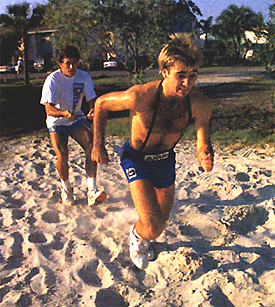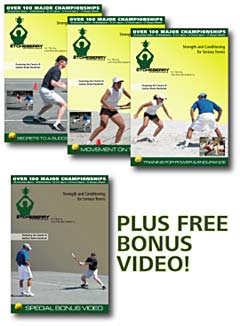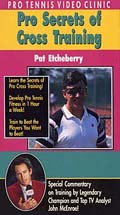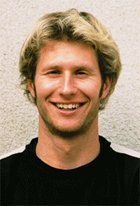My Etcheberry Adventure
Giancarlo Andreani
As an elite strength and conditioning coach, Pat Etcheberry has a unique perspective. Few coaches have seen as many athletes in their most challenging and their most triumphant moments.
His track record proves he knows what it takes if you want to win the French Open or break the Grand Slam record. But he also knows how to help any player or coach improve their tennis and/or teaching. (And possibly even put an end to that losing streak against that pusher that returns every ball.)
What would it be like to train with Pat and learn to use his system in my own game and in my on court teaching? I was about to find out, because I had signed up for his training certification course in Los Gatos, California. The idea was not only to add a new dimension to my knowledge as a player and a coach, but to report on what the whole experience was like for Tennisplayer subscribers.
An Inside View
I have often wondered why the tennis media is not more interested in interviewing the conditioning coaches of the top players. The field is not short of interesting characters, and their insights and anecdotal stories rival those of the regular tour coaches.
As I was driving down to Los Gatos for the first day of the program, I wondered what it must have been like to work with Pete Sampras, Jim Courier, Justine Henin, Jennifer Capriati--all these fantastic players I had been studying for the past fifteen years. I was pretty sure Pat Etcheberry had some great stories.
I had never met Pat, and my impressions of him came from his articles on Tennisplayer (Click Here) and the material I received before the course, including his new DVDs. (Click Here.) From these, I had a beginning knowledge of his system, but I also thought I had a sense of what he was about as a person: integrity, hard work, and a dry sense of humor.
How would that match up when I met him in person? As I walked into the conference room, none other than Pat Etcheberry immediately greeted me. He was sitting casually on a table in front of the room chatting with the people in the front row. As I set up my video equipment, I could hear the familiar voice I had heard for the past few days on the video and DVDs. It fit perfectly with my picture. He seemed so naturally affable and without a hint of an overbearing ego.
Day 1
The course I had signed up for was two full, intense days, combining classroom presentations with on court demonstrations and work in the gym.
Day 1 started with an in class overview. Pat covered the importance of warm ups and stretching, including what to do and how much to do when. He went over planning a year long schedule and nutrition. He also explained the importance of communication between fitness and tennis coaches. Then he went over the components in the actual training.
One component was aerobic work in the form of sprints and longer "strides," where players might run anywhere from 20 yards to 400 yards at various levels of intensity. This work could also be done on a treadmill or on a stationary bike.
The second component was anaerobic. This took the form of tennis specific movement drills on court. Although common now in high level training, Pat helped pioneer this form of training, and has created literally hundreds of drills and variations that simulate all the movement patterns of actual play.
The players train in work/rest cycles that also mimic the patterns of point play. For example, bursts of 30 seconds, followed by 30 seconds of rest.
The final component was strength training, work that could be done either in a gym, or on the road without extensive equipment. Again Pat was one of the first to really tailor the type of strength training to the demands of the sport.
All of this was interspersed with the stories I was hoping to hear. With a twinkle in his eye he explained how the great Pete Sampras actually forgot to eat before his 1993 Wimbledon final against Jim Courier. When Pat asked him why, Pete's answer was, "Uh, because I was nervous." That got a round of laughter.
Another fascinating tale was how Jim Courier and Justine Henin independently developed the same obsessive practice pattern. Both had a superstitious need to hit fifty perfect forehands in a row. A miss at number forty-nine, and it was back to forehand number one.
Another story about Courier was his obsession with training and practicing, even in the midst of a Grand Slam. Pat described how Jim would play his first round match at the French Open. Then on the off day between rounds, he would play an intense, full length practice match.
Pat could not understand this, and didn't approve. Later he realized that Jim had a deep need to prove himself every day. It may have shortened his career, but it was part of the package that allowed him to achieve what he achieved, including those incredible titles at Roland Garros.
Another interesting Courier story. What was Jim's biggest regret? "Too many girlfriends?" another a teaching pro from Florida asked. "No," said Pat, smiling and shaking his head. "Doing that famous Nike commercial."
In case you don't remember, the commercial, shot in black and white at Saddlebrook when Jim was #1 in the world, showed Jim training and doing some of Pat's patented drills, for example, dragging a tire behind him in the grass behind the tennis courts. It was an inspirational commercial that brought Pat a lot of attention. But it also altered the landscape at the top the tennis world because it showed how Jim had gotten an edge.
"As soon as everyone saw how hard we were training, the rest of the players started to train harder and everyone raised their level and became better athletes," said Pat.
Interestingly, a member of our group turned out to be a developmental coach from Argentina who confirmed that many players and coaches in his country had been deeply influenced by the commercial. "We saw the commercial in Argentina, and we all acknowledged that we had to train harder."
Currently, there are eleven players from Argentina in the top one hundred and all are notorious for exceptional physical condition. So who knows how much influence Courier is still having on the tour to this day.
So most world class players rely on this type of complex cross training. But as a Tennisplayer subscriber how does that apply to you, or to me for that matter?
The benefit is probably much greater for the average player. Why? Everyone at the world class level is now training hard off court. At the club or sectional level, very few people are. The opportunity to get a real edge is huge.
In his own article on conditioning, Tennisplayer writer Kerry Mitchell explained how his off court training led to an "incredible jump" in his game and competitive results in Norcal senior tournaments. (Click Here.)
Although he has never written about it on the site (yet anyway), I also know our own editor John Yandell has trained intensively using Pat's system. He got to know the system well while producing an instructional video with Pat. (Click Here.)
At the time he started training, John was starting to play tournaments again, and ended up ranked in the top 20 in the USTA Norcal men's 40 and over division several times. He also achieved a personal goal of winning a 4.5 NTRP event, 15 years after accomplishing the same feat in the 1980s.
For a change, I turned it around on John and interviewed him about his experience. How exactly did you benefit, I asked?
 |
AA and his first trainer, on the beach, in their younger days. |
"For me Pat's cross training was huge. Far and away, it got me into the best shape of my life, even though I was over 40 when I started."
"There were plenty of great players I found I couldn't beat in the seniors, but I think it helped me find out what my real potential was. That was pretty satisfying."
"The most satisfying thing though was winning that 4.5 tournament. That's not easy in Norcal. I actually won 7 matches in 8 days, including a couple of long, tough matches against guys in their 20s."
"Using the warmup and the stretching were also critical for me because they helped me walk on the court feeling loose and able to move from the first point."
The Andre Surprise
My ears really perked up when Pat started talking about his early training with my hero, Andre Agassi. I have been a huge AA fan since the age of nine (when I was nine, not Andre). During a 15 year span, I have acquired volumes (and I mean that literally) of information about him. But I had never heard that he had worked with Pat.
This happened during the late eighties, just at the start of Andre's professional career when they were both at Nick Bollettieri's famous academy. Pat actually traveled with Andre, often going to Las Vegas where Andre preferred to train.
He remembers using a specific return drill with Andre based on an open stance set up, followed by aggressive forward weight transfer. Andre perfected this move and it became the foundation of his return game.
Pat explained that for all the star players he worked with and many more less well known pros, intense physical training and conditioning could be a character revealing experience. Would a world class player allow Pat to push him or her beyond his or her comfort zone? How would they react when they hit the wall, trying to hide tears in some cases, as the Florida sun beat down and Pat shouted "Give me one more!"
On the Court
Although I had been fascinated all morning, Pat now said, "This in class part is the boring stuff." To his way of thinking, the real fun began after lunch, when we moved to the court.
The afternoon started with a warm up that had most of the participants huffing and puffing. Then he demonstrated his signature conditioning test using the service box.
It goes like this. With your racquet in hand, you position yourself in the middle of the service box. Get a friend or coach with a watch, and then count how many times you can move across from the singles sideline to the center service and back line touching the line on each side with your racket--you have 30 seconds.
Pat likes this drill to establish a training baseline for two reasons. First, the size of the service box is the same anywhere in the world. So if he is in Florida or Spain it's exactly the same. Second, a tennis match is a series of sprints with built in recovery time.
You do the test three times, with 30 seconds of rest in between. This mirrors the work and recovery cycles of actual points. If on your first try you achieve say 30 touches, but the number drops on the second and third try, you have got some work to do.
Try it yourself and see how you compare to the great players in tennis history Pat has trained. Pete's best ever service box drill number was 37, three times, Jim Courier's was also 37.
But the all time leader is still the two time French Open champion Sergi Bruguera at 38, three times in a row--and that on a clay court. Agassi's best number was 36. Justin Henin can do around 32 to 33.
If you feel discouraged because your numbers are not reaching 30, feel better. U.S. Open finalist Greg Rusedski's best score was 25 before he started working with Pat.
There are literally dozens and dozens of these highly focused on court drills in pat's repertoire. We went over a range of them that equipped us to use them in coaching, and also to incorporate more by studying his video and DVDs. See below.)
Every participant received a chance to work with Pat one-on-one during the on court portion. If Pat was not satisfied with the correct footwork sequence, he would stop the drill immediately, and correct the movement until it was executed the correct way. Pat showed us all great natural patience and never left a question unanswered.
The final item on the Day 1 agenda was a trip to the weight room. The number one reason for tennis players to workout in the gym is to prevent injuries. In fact injury prevention was one of Pat's mantras throughout the course.
Most of the injuries he finds are in the shoulders and lower back. But that isn't what most players train. What doe Pat encounter when he visits high school or college teams? "The first thing I see the kids do is bench press. Then they the do dumbbells curls and look at their biceps in front of the mirrors."
"They don't do legs, core or shoulders. That is not really what you need for tennis. You need a strong upper body--with the emphasis on the shoulders."
Pat demonstrated all the exercises in two ways. The first was with equipment found in a state of the art gym. Then, Pat showed us how to get the same results on the road or at home using things such as a chair, physio balls and your own body weight.
If you are working in a gym or a room with a large mirror Pat also explained that you can work on your technique and posture in a powerful different way. Sound silly? Pete Sampras loved it because he could see with his own eyes if he was balanced and executing the movements correctly.
And then another great story about Sampras. Pat wanted us to know how most people underestimated Pete's strength and speed.
"Sampras's strength was deceiving," he explained. "Pete could throw a medicine ball harder than any tennis player I ever trained. In fact he could throw it as hard or harder than some of the pro football players."
One of those football players was Charles Woodson, then a cornerback for the Green Bay Packers. One day Pat asked Pete to come and join a training session with Charles.
"Charles was surprised how quick Pete was and how well he could jump and some of the things he could do in the drills." "As an athlete Pete was a lot better than most people thought."
Pat explained when he did sprints on the stationary bike, Pete could generate phenomenal bursts of speed. He could crank the bike up to 250rpms, and sustain this in repeated in 30 second bursts.
Remember that 80rpm is considered the right speed for most people. Try it yourself and see how hard it is to sustain even 100rpms for 3O seconds. Now imagine reaching 2 and a half times that speed. To this day, Pete's numbers are still the highest Pat has ever seen.
We spent a solid 1.5 hours in the gym learning tennis specific exercises that involved the body from head to toe, and that concluded the first day of the Etcheberry experience--an incredible first hand overview of his whole system.
Day 2
The goal of the second day was to put our new knowledge into practice. In the morning we were all asked to design a training program for a real or imaginary client. I created a program for a fifteen year old high school and tournament player, not unlike my beloved step daughter, Sophia.
After laying out practice schedules, agility drills, strength training, and recovery time, we had to get an approval from Pat. He reviewed every participant's program personally and suggested changes if needed. The immediate feedback was great, much better than having to wait to receive test scores in the mail!
Then after lunch we partnered off to take each other through the programs we designed, alternating between the roles of coach and client with our partners.
For me this last part of the program brought everything we had learned together. I felt that I'd had been taken inside an elite world and shared the experiences of some of the great players in tennis history. It created a new framework for looking at my own game and added a new dimension to my ability to work with students.
There was a lot of confidence in seeing and understanding how important physical training has been at the top of the tennis world, how it was done, and what a huge difference it can make for any level. Probably it was worth it just for the stories. They had an inspirational effect.
My conclusion is that this kind of program is highly recommended for any student of the game. It's almost a requirement if you are coaching junior players.
Now in my living room I can watch the training tapes and DVDs and when I hear Pat urging his athletes on with some of his patented phrases. "Allez! Show me what you got! Quick like a cat!" It makes me smile now because I know the sound of that voice in person.
And yes, I plan to train in the system myself (and possibly train Sophia as well), and hopefully, will have something as positive to report as Kerry and John. If you want to join the adventure, you can read about Pat's training system here on Tennisplayer, (Click Here) and also, click on the links below to find out more about Pat's video and DVDs. Check with your doctor though before you start. And if you get into it and reap benefits, we want to hear about it on our Forum.
 |
The Etcheberry Experience DVD Click Here
Pat Etcheberry shares his training secrets in this series of DVDs for players of all ages, their coaches, and trainers. Learn the drills, exercises and words of tennis wisdom that Pat gave to players like Pete Sampras, Andre Agassi, Jennifer Capriati, Martina Hingis, Jim Courier, and Justine Henin. |
 |
Pro Secrets of Cross TrainingIn Pro Secrets of Mental Toughness, Pat Etcheberry trains you to develop the same conditional skills used by the world's top professional players. Overcome choking, play your best tennis under pressure, become the player you really want to be! Click here for more info |
|
 |



